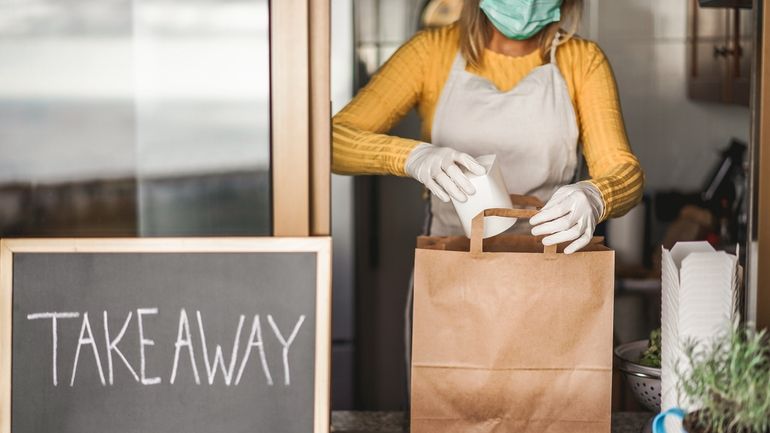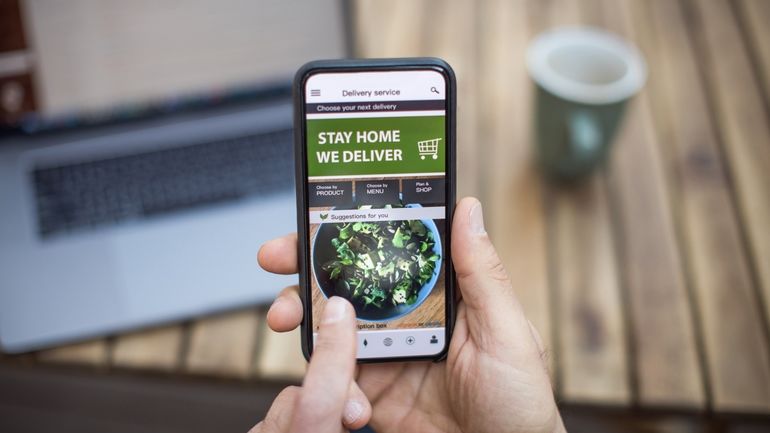According to Penn State University research, the restaurant industry lost $25 billion in sales in just the first few weeks of the COVID-19 pandemic. One restaurant business model in particular has been struggling more than others during this challenging time is full service restaurants (FSRs). FSRs have been facing greater challenges than casual restaurants, largely due to the restrictions on on-premise dining – the primary revenue stream for most FSRs.
So what can FSRs do to cope with dining restrictions that may stick around for the foreseeable future?
For some restaurateurs, the answer is pivoting from dine-in to a takeout-focused, casual restaurant business model. This pivot involves making changes such as implementing a takeout-friendly menu, upgrading your technology, and creating a system for contactless order pickup.
In this guide to shifting your restaurant business model from an FSR to a casual restaurant, you’ll learn:
- Why FSRs are pivoting towards casual concepts
- How to make the change from FSR to a takeout-focused restaurant in six steps
- Examples of successful pivot restaurant concepts
Let’s get started!
Why FSRs Are Pivoting Towards Casual, Takeout-Focused Concepts
2020 has been a challenging year for full service restaurants. Here are the obstacles full service restaurants are facing, and the perks of shifting towards a casual, limited service restaurant concept.
Current challenges FSRs are encountering
The FSR business model focuses on providing hospitality through person-to-person interaction. Unfortunately, capacity limitations and social distancing measures brought on by the COVID-19 pandemic have severely limited traditional on-premise dining. Most full service restaurants can’t serve as many customers as they need to turn a profit.
The numbers show that FSRs have been at a disadvantage throughout the pandemic. In the United States, FSR sales were down 25% in June 2020 vs June 2019, while casual restaurants experienced a less severe 13% decrease. Restaurant sales in Canada followed similar trends: FSR sales dropped 67% and casual restaurant sales dropped 33% in March 2020 vs March 2019.
Because FSRs focus on on-premise dining, many aren’t equipped to fulfill takeout orders at the same scale as casual concepts. A study by Dataessential asked restaurants if they were closed for on-premise dining but open for takeout. Only 56% of fine dining restaurants and 75% of midscale restaurants responded yes, while 87% and 90% of fast casual and fast food concepts, respectively, said yes. According to the same study, full service restaurants were also more likely to be closed entirely during the pandemic than more casual concepts.
Benefits of being a casual restaurant right now
It’s clear that casual concepts are more likely to have stayed open during the pandemic, and that’s because of some unique benefits to their business model:
- Casual concepts emphasize takeout and pickup, which are safer business models during a pandemic than on-premise dining.
- They focus on speed and convenience, which are selling points for customers who are wary about being out these days.
- There’s no limit to how many customers takeout-only concepts can serve, unlike FSRs that presently have to deal with capacity restrictions.
Based on these factors, transitioning from a full service restaurant business model to a more casual restaurant concept appears to be a smart strategy for restaurateurs trying to keep their operations afloat.
6 Steps to Pivot Your Restaurant Business Model

If you’ve decided to make the leap and shift from a full service restaurant to a more casual concept, here’s how to do it.
1. Start with a Business Plan
While you don’t necessarily have to rewrite your restaurant business plan from scratch, it’s helpful to go through much of the exercise to understand the market for a new concept and create a solid strategy for executing it.
Reconsider the following sections of your restaurant business plan before proceeding:
- Market analysis: Research whether other casual restaurants in your area are serving food similar to yours. Is the market oversaturated, or is there an opportunity for you to add something new to the mix as a casual concept?
- Forecasting: How would the finances of your business look if you changed your restaurant business model? Is there an opportunity to increase your revenue and profits?
- Funding: How much money will you need to pivot? Where will this money come from: investors, savings, or revenue?
- Rebranding: How would the identity of your restaurant change? Consider hiring restaurant consultants to help you successfully position this shift in the public eye.
Use your restaurant business plan as a blueprint for your transition from an FSR to a casual restaurant.

Download this customizable restaurant business plan template to create a professional business plan for your new venture.
2. Revisit Your Menu
To make a successful pivot, you may have to change your menu. Remove any dishes that don’t travel well or take a long time to prepare. Speed and deliverability are the keys to success as a casual restaurant concept.
Add more menu items that retain their quality in transport and are good when reheated. Items like noodles, grilled meats, and sandwiches are suitable options for a takeout-focused concept.
3. Adjust Your Operations for Takeout
As your restaurant shifts towards fulfilling more takeaway orders, it will need less front-of-house space and more back-of-house space. Start by optimizing your kitchen layout for quick preparation – an assembly line configuration is ideal.
You’ll also need to create an area from which guests can pick up their orders. If possible, create a drive-thru ordering system. You don’t need a window to make it happen. You can create a makeshift drive-thru with tableside ordering tablets. Alternatively, you can place takeout orders on tables or shelves near your restaurant’s entrance, where guests can grab them and go. A more tech-savvy option is to invest in food lockers that customers unlock with codes they receive when their orders are ready for pick up.
Additionally, there are several ways to execute curbside pickup. If you have a parking lot, reserve several spots near your restaurant’s entrance for this service. Mark these spots with signs that display a phone number for customers to call when they arrive. When customers call, have them tell you the name associated with their order. Then, send a team member to the car to hand off the meal.
If your restaurant doesn’t have parking spots, there’s no need to fret. You can let customers know which phone number to call when they arrive at your curb via your online ordering platform. Or you can write the phone number on a large sign and post it in your restaurant’s window, near the curb.
And don’t forget to stock up on proper takeout food packaging well in advance!
4. Upgrade Your Technology

If your restaurant has only taken online orders only via third-party platforms thus far, it’s time to shift to a better option.
When evaluation different options, keep the following in mind:
- Look for an online ordering platform that lets you keep your profits rather than taking a commission from you.
- Choose an online ordering system that integrates with your POS so that any online orders are sent directly to your kitchen.
- Add an online ordering page to your restaurant’s website for maximum impact and exposure.
If you plan on accepting takeout orders on-premise, give customers a contactless way to do this with self-service technology. Place QR codes that link to your online ordering page throughout your restaurant to reduce interactions between customers and staff. You can also opt for self-ordering kiosks that allow customers to order on their own from a touchscreen tablet. Just make sure to place hand sanitizer and signage next to your kiosks asking customers to use it before and after touching the hardware.
It would also help if you also looked into creating a loyalty program for your new casual concept. Gamify your customers’ purchases to incentivize them to spend more, and reward them for their repeat business.
Keep in mind that a loyalty program also doubles as a customer relationship management tool, which you can use to collect data from customers and then target them with personalized marketing campaigns.
5. Repurpose Staff
A shift in concept also requires a staffing shift. While a takeout-focused restaurant will require more kitchen staff and fewer front-of-house (FOH) team members, this doesn’t mean you have to let staff go.
Instead, think about repurposing your FOH team. You can use them to take drive-thru orders, manage phone or online orders, and pack food to-go. If you plan on offering delivery, you may want to hire in-house delivery drivers rather than using ones provided by third-party apps for more control and savings. You can even retrain your FOH staff to work as delivery drivers.
6. Communicate Your Restaurant Business Model Pivot to Customers
After taking steps one through five, it’s time to make your business model pivot official. Create a grand reopening event (keeping social distancing in mind, of course). Invite your most loyal customers to this exclusive event to thank them for their support. You should also invite press, food influencers, family, and friends to spread the word about your new casual restaurant concept.
It’s important to conduct ongoing marketing after your grand reopening to ensure people who didn’t attend know what to expect from the new incarnation of your business:
- Send coupons to locals to get them to try your new dishes or to place takeout orders.
- Let your existing customers know about the pivot through an email marketing campaign.
- Alert your social media followers of the exciting changes they can expect when they visit your restaurant.
Create buzz around your reopening to kick-off your new concept successfully.

Drive sales and brand awareness with our free social media templates for restaurants.
Examples of restaurant business model pivots from FSRs to casual concepts
It’s natural to want to know how other restaurants have made the leap from full service concepts to casual restaurant concepts before making the transition yourself. Take inspiration from these trailblazing restaurants.
Nyum Bai – Oakland, CA
Oakland’s award-winning Cambodian restaurant, Nyum Bai, made the permanent switch from an FSR to a takeout-focused, fast-casual concept in early summer 2020. According to Eater, Nyum Bai now features a window for ordering and picking up takeout, limited outdoor and indoor seating, and a display case for grabbing pre-made food to go.
Owner Nite Yun had to do more than just adjust her restaurant’s service style. She also had to shift its menu from family-style meals to a takeout-friendly menu focused on Cambodian street food favorites.
Clyde Common – Portland, OR
Portland’s Clyde Common restaurant and bar is pivoting to accommodate the current situation. A message on their website reads:
“Our beloved restaurant, Clyde Common, has always grown and adapted to the changing times… We have always been at the forefront of innovation with our bar, and we have always aimed to meet the ever changing needs of our community as we’ve watched it grow over the thirteen years we’ve been here. And once again, we have been tasked with adapting to a very different world.”
How are they adapting? The restaurant is taking a two-prong approach. They’ll maintain an aspect of their original full-service style via Clyde Tavern, which has outdoor seating.
But they’re also welcoming a new addition to their restaurant called Common Market, which “is an all-day counter serving simple prepared dishes from our kitchen, and thoughtful staples from local purveyors which are available for pick-up or delivery,” according to the website. Eater reports that the market will primarily focus on to-go sandwiches.
The Buffalo Jump – Cape Code, MA
Locals of and vacationers to Cape Cod once knew Buffalo Jump for its farm-to-table tasting menu. Eater reports that the restaurant is now shifting towards a casual, takeout-focused concept that serves breakfast and lunch to-go.
The menu changes daily and since online ordering isn’t available yet, customers are encouraged to come to the restaurant to place their orders. They can take their food away or enjoy it at the farm’s socially-distant tables.
Takeaways: A Restaurant Business Model Pivot Can Help You Make It Through the COVID-19 Pandemic
There’s no question that the COVID-19 pandemic has affected full service restaurants more severely than casual restaurant concepts. But, here’s the good news: when FSRs pivot towards takeout-focused restaurant business models, they can tremendously increase their chances of thriving throughout the pandemic.
When you revisit your restaurant business plan and menu, shift towards takeout operations, upgrade your technology, repurpose your staff, and market your reopening to customers, you’ll orchestrate a successful concept pivot.
Learn how you can pivot your full service restaurant towards a casual concept with TouchBistro’s Online Ordering and Loyalty.
Sign up for our free weekly TouchBistro Newsletter







